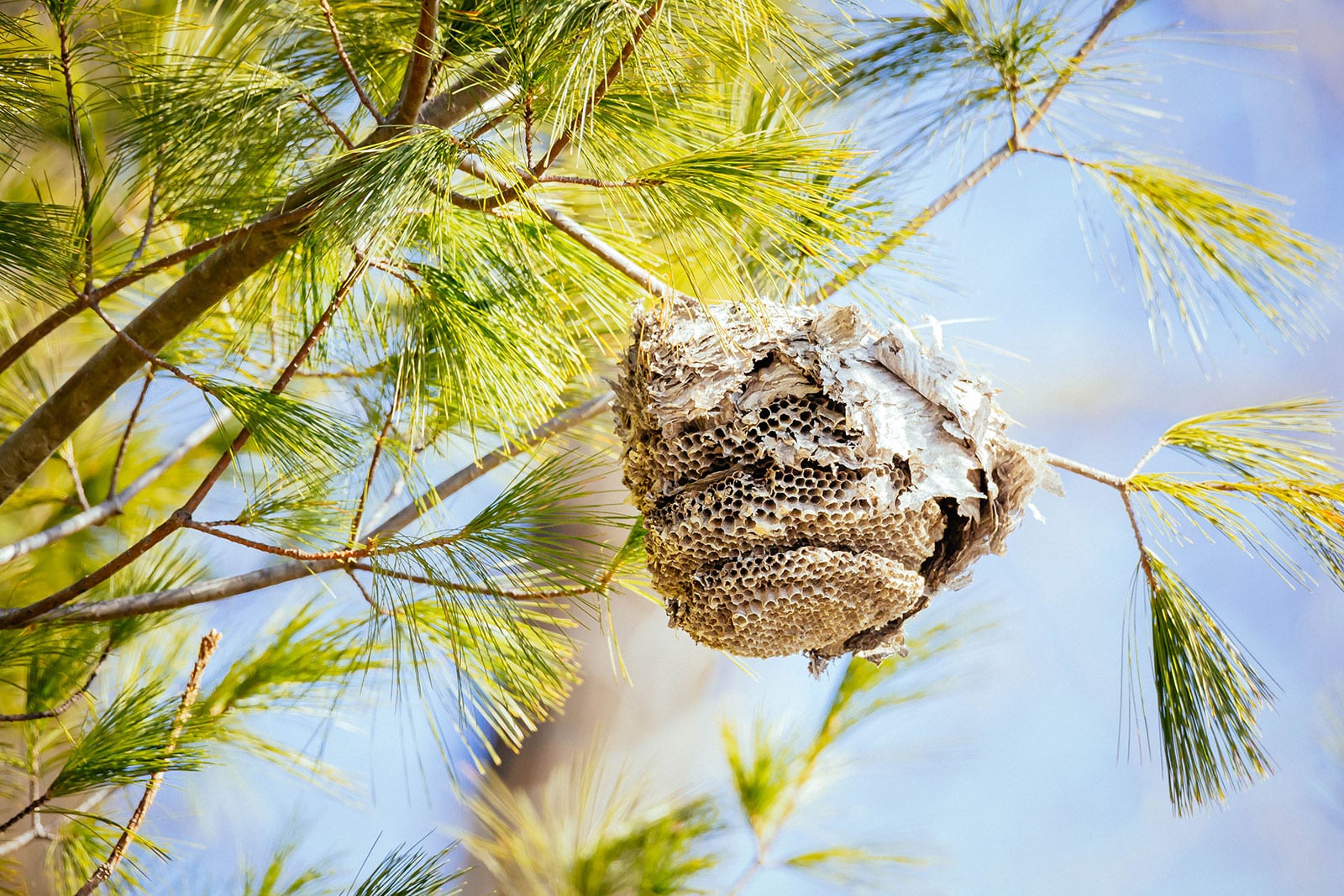If you’ve ever had wasps infest your yard, you’ll know that it can be an absolute pain—both figuratively and literally. Some species, like yellowjackets, can really ruin your summer picnics and take the fun out of gardening with their constant pestering and painful stings.
What should you do? How do you get rid of wasps? Should you call an exterminator, or can you deal with the problem yourself?
Let’s have a look at everything to do with getting rid of wasps, so you can enjoy your garden in peace.
Disclosure: If you shop from my article or make a purchase through one of my links, I may receive commissions on some of the products I recommend.
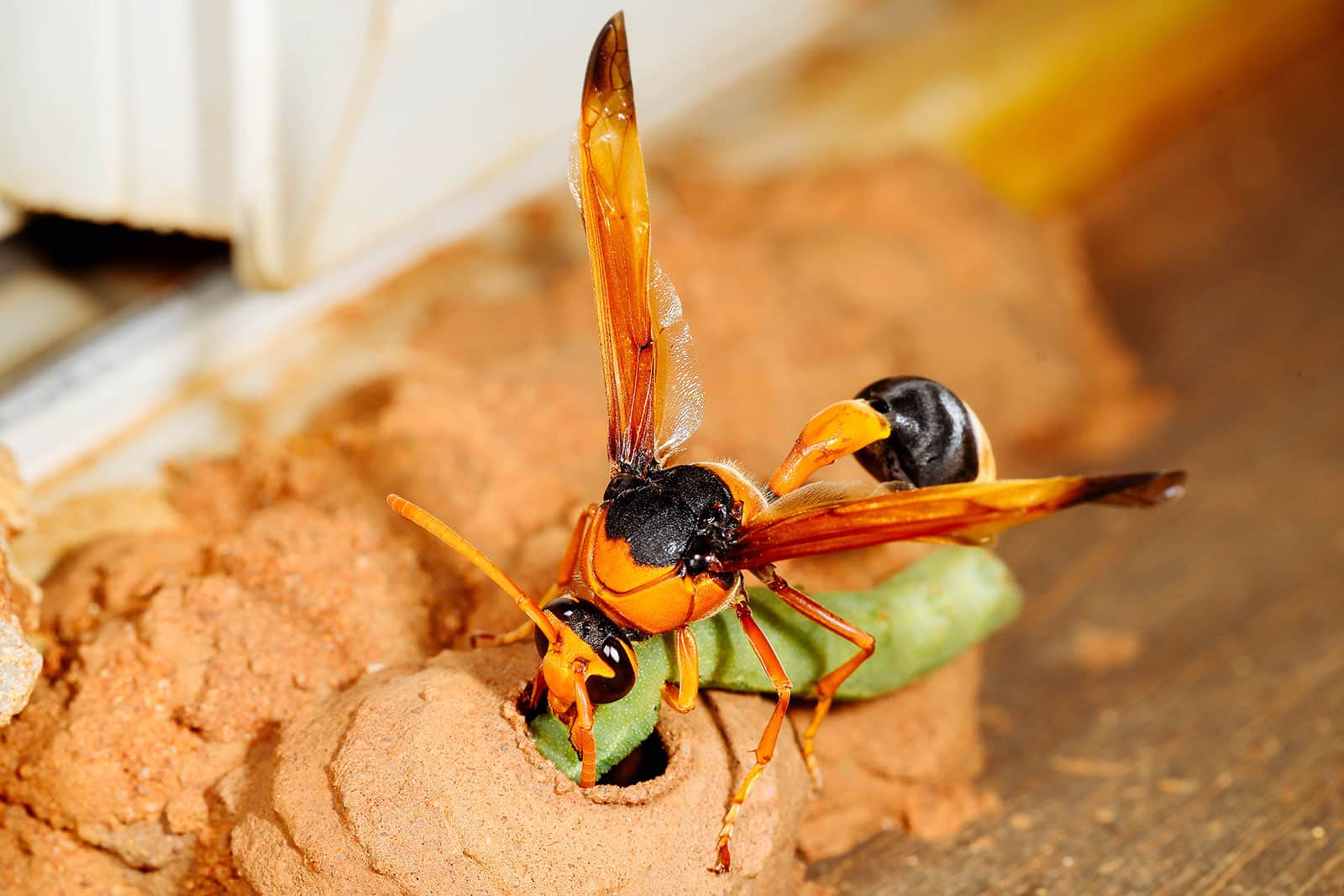
Are wasps always bad?
Let’s start off with a few wasp facts to help you figure out who you’re dealing with here.
When asked to think of wasps, most people’s thoughts go to yellowjackets. This is a common name for a bunch of different social wasps in the genera Vespula and Dolichovespula.
And yes, these guys can definitely get annoying, as they like all of the same foods we do: soda, sweets, meats, etc. They love setting up shop in or around our houses. When disturbed, they can respond aggressively, and they’re able to sting multiple times.
However, yellowjackets are by no means the only wasp species out there. There are many wasps, especially solitary types, that will go about their business without ever bothering you.
Additionally, even the aggressive striped menaces among wasps do fulfill certain useful roles in your yard. They eat other annoying bugs and they actually help in pollinating flowers.
If you’d like to know more about wasps, identifying them and what roles they play in your backyard ecosystem, have a look at the full article on common types of garden wasps.
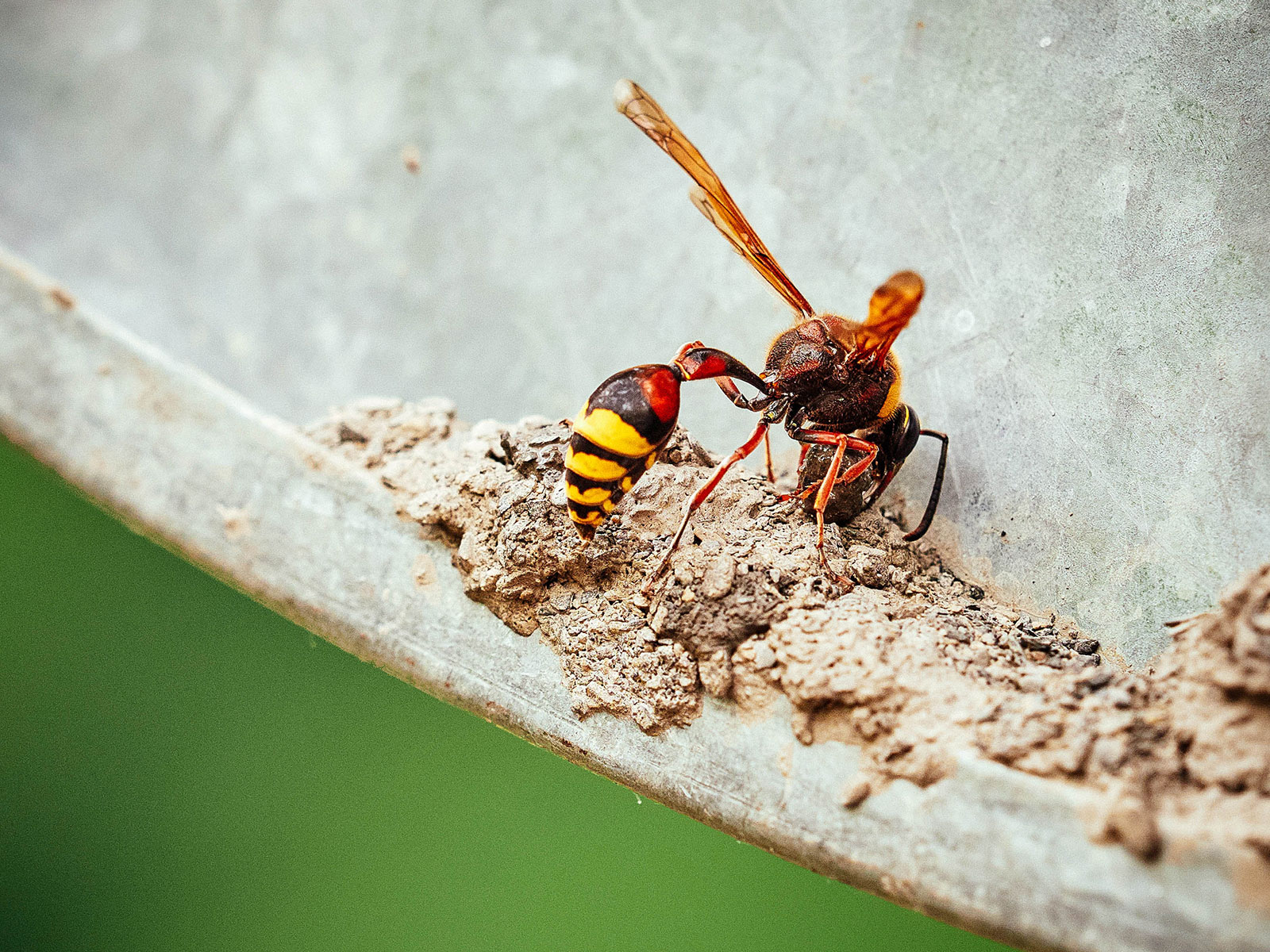
What attracts wasps?
If you’re thinking of having a BBQ and worried about being hassled, or if you just want to be able to tend to your plants without getting stung, it helps to know what attracts pest wasps. Prevention is better than cure, and there are things you can do!
Yellowjacket wasps tend to be attracted to our homes because they offer everything a colony needs to thrive: wood to chew into pulp for nest building, spots that offer protection from the elements, plenty of food and water. It’s no wonder they often build their nests on porches, in sheds and under decks.
In order to help prevent wasps from settling around your home and in your yard in the first place, try the following:
- Place trash in an inaccessible location in tightly closed bags until it’s picked up, or at least away from your home.
- Remove any other sources of food and water from your outdoor living spaces: bird baths, fruit fallen from trees, etc. It can even help to place fragrant flower beds a bit further away from your house (or at the very least, away from the outdoor areas where you cook or entertain).
- Seal openings in the exterior of your home, as well as in places like sheds, barns, and pool pump buildings. Fill up holes in the ground.
- Cover any storage bins, composters and the like. Consider spraying them with essential oils like peppermint, clove, and geranium, or using a premade peppermint oil spray like this one; it sounds silly, but there are actually some studies that indicate wasps really dislike these sharp, strong scents.
- Do regular sweeps so you can catch and remove any new nests before they become a threat.
If you want to prevent attracting wasps while working or hanging outdoors during the summer, a few things that you can keep in mind are:
- Wasps are attracted to sweet smells. Keep your lunch tightly packed and try to avoid wearing perfume or heavily scented lotion.
- Studies suggest that at least some wasp species may have color preferences. In one experiment, for example, they preferred pink and yellow. Try to avoid wearing bright colors and go for black or neutrals instead.
- Plants such as mint, citronella, and wormwood are known to repel wasps (as well as other pesky insects like flies and mosquitoes). Grow these herbs along your borders, or plant them in large pots (on wheels) and move them around outside as needed.
- Use the essential oil trick: Put some peppermint essential oil on yourself or around your lunch area.
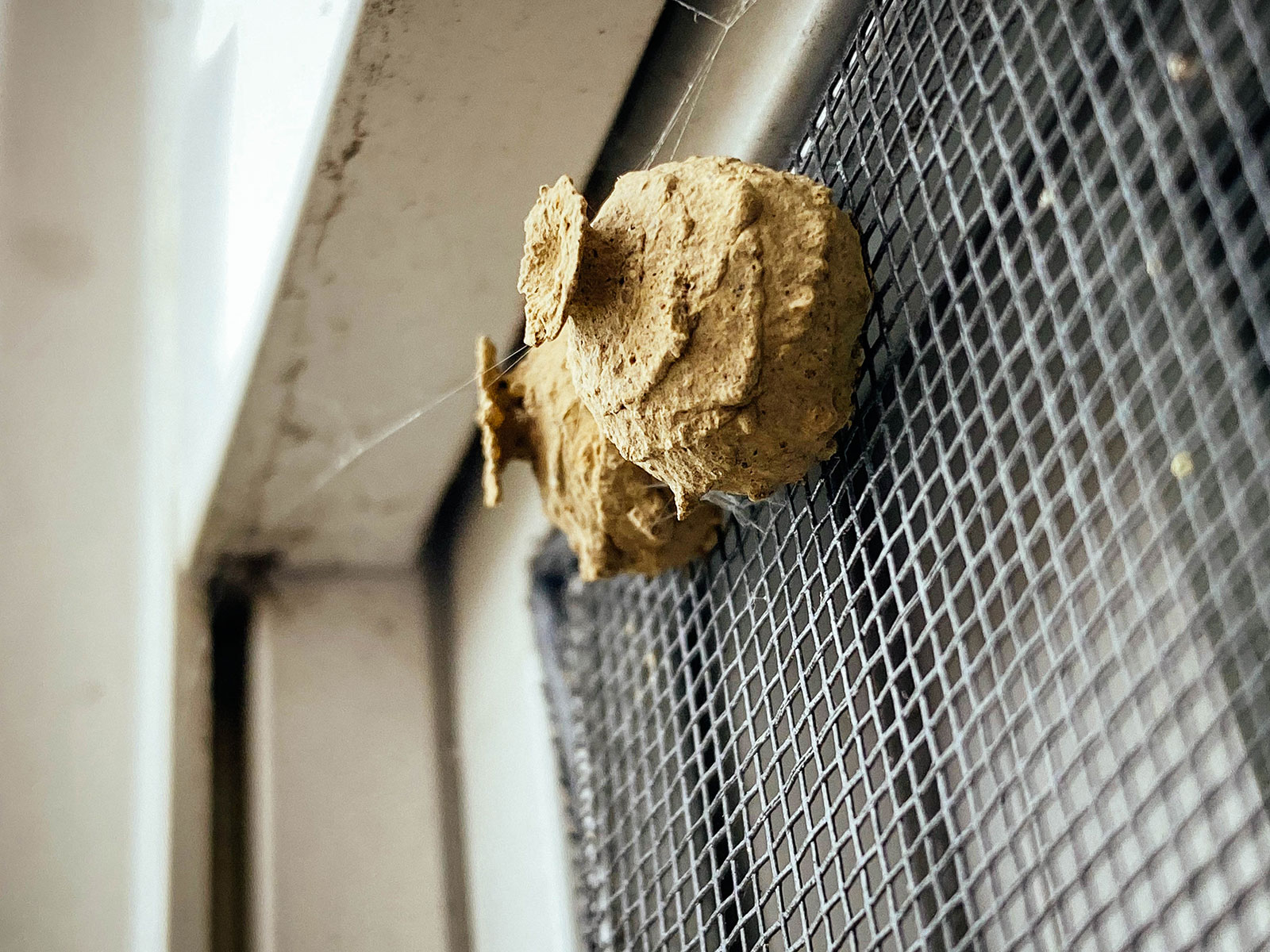
How to remove wasp nests
No matter how diligent you are, sometimes wasps will find a way. They can be pretty darn persistent!
If they’ve managed to establish a nest, in some cases it’ll be necessary to get rid of it.
Recommended products for wasp control:
- Minty Mint Insect and Pest Control Spray
- Wondercide Wasp and Hornet Killer (Aerosol Spray with Natural Essential Oils)
- STEM Botanical Spray for Wasps, Hornets, and Yellowjackets
- Hot Shot Non-Staining Wasp and Hornet Killer
- DeltaDust Waterproof Insecticide Dust
When should you remove a wasp nest?
A wasp nest in a fruit tree all the way in the back of your yard may not be worth removing. I tend to leave European hornets to go about their useful bug catching business freely! The same goes for nests belonging to the more inoffensive wasp species, like mud dauber tubes or small paper wasp nests.
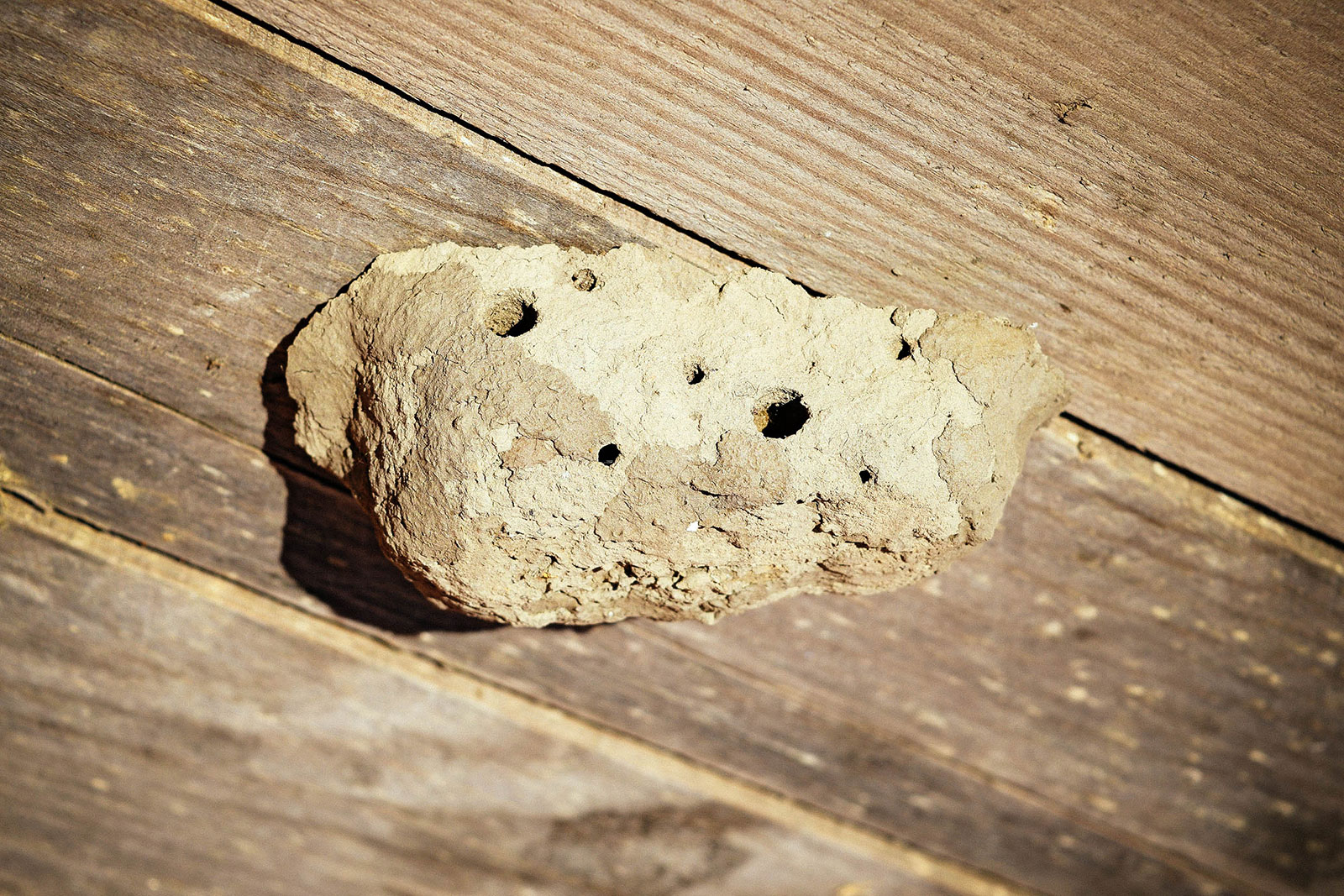
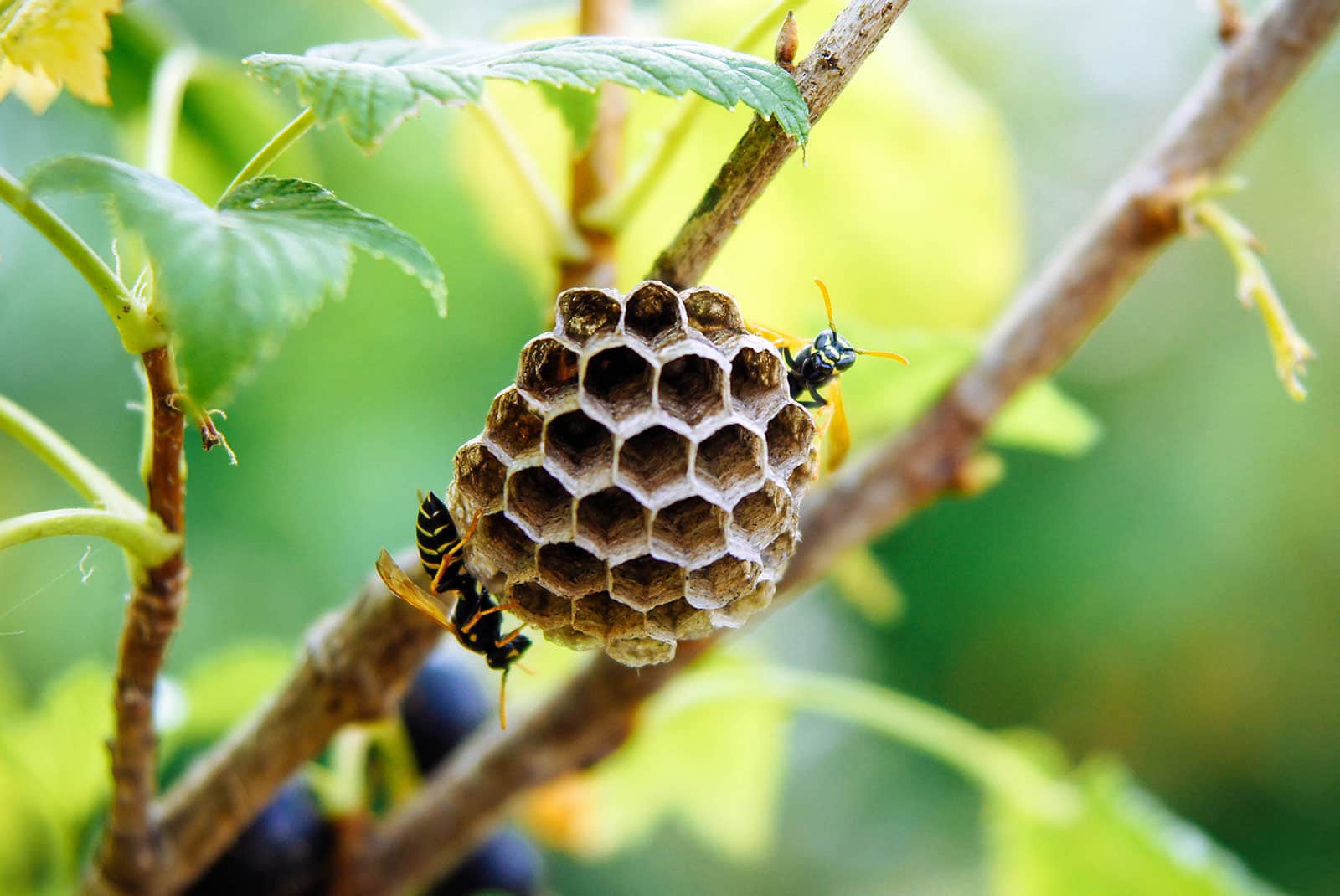
Additionally, if fall is already well on its way, you could consider just leaving the nest. The wasps will die off soon.
Things change if the nest is very close to a gathering area, like your porch. The same goes for zones that children or pets play in, as they can accidentally disturb the wasps and get attacked. Nests belonging to very aggressive species, like the bald-faced hornet, are also candidates for removal.
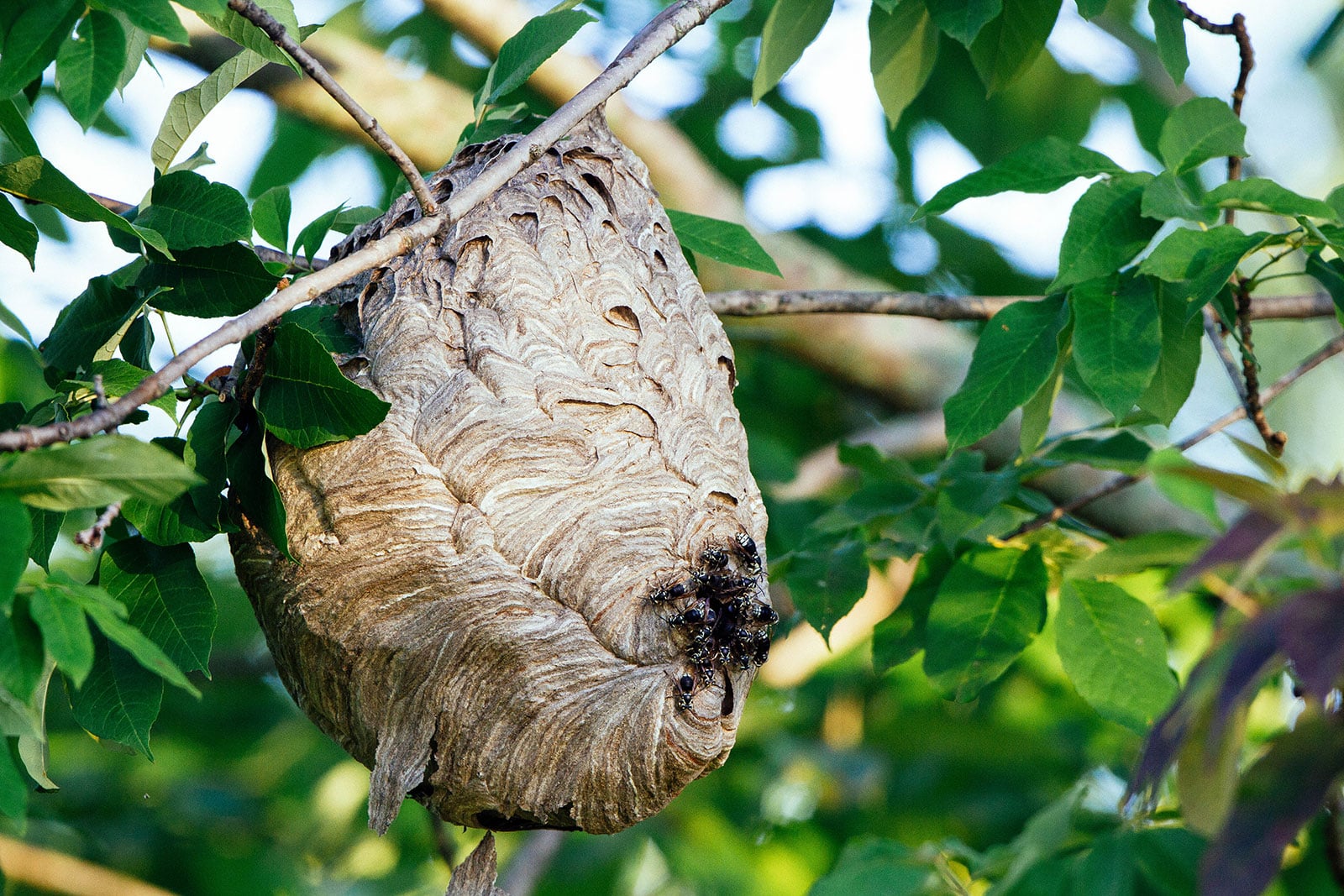
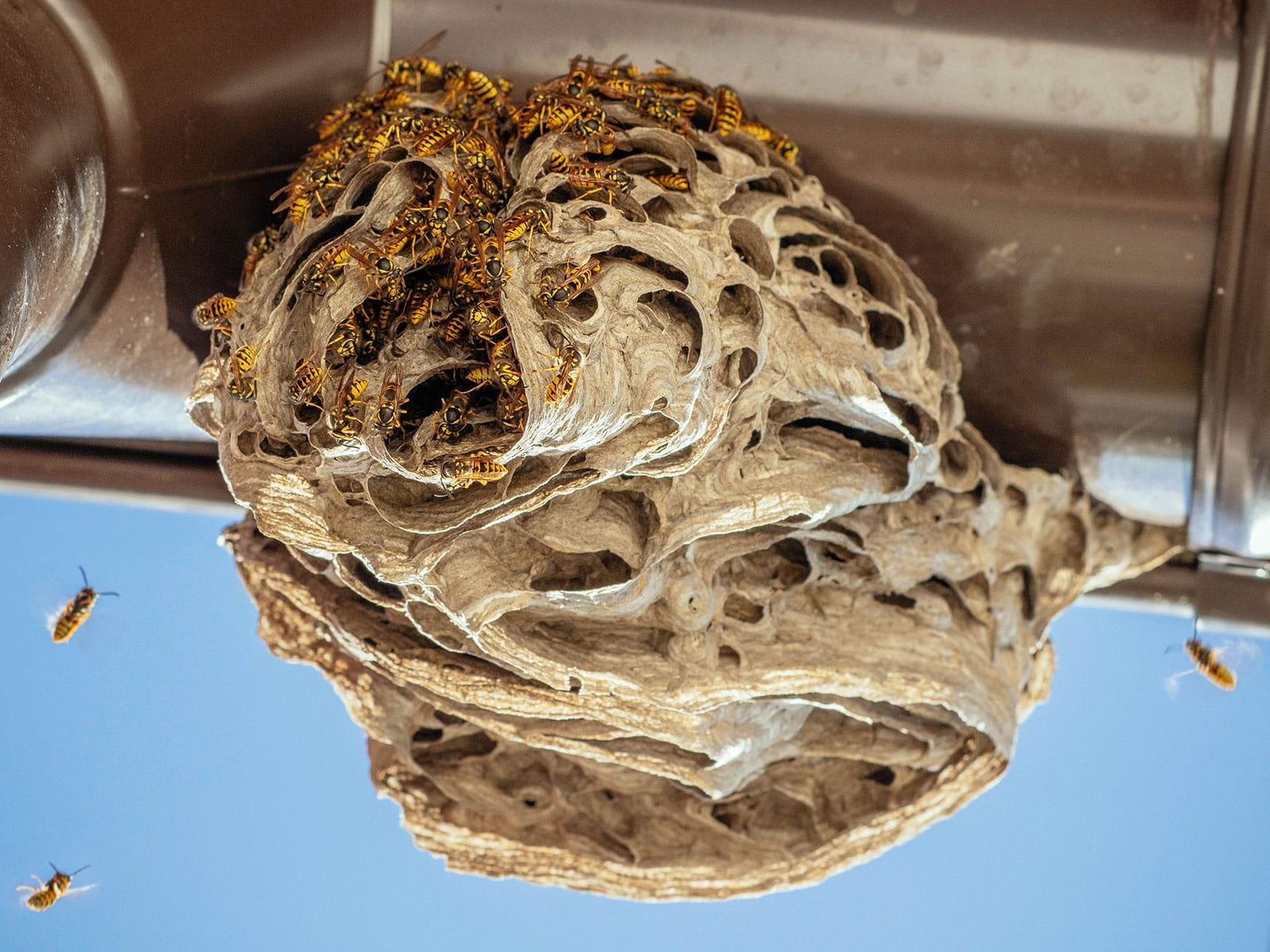
How to remove a wasp nest
If you’ve decided the nest has to go, it’s important to judge whether you can do it yourself or if you should let a professional take care of it.
It’s generally fine to remove small and beginning nests yourself, although if you have your doubts, calling an exterminator may be worth the peace of mind. Large nests and nests that are in difficult-to-reach spots are best left to the professionals.
Why? Because if you disturb and then fail at getting rid of the nests of aggressive wasps, like yellowjackets, you’ll end up with some very angry (and very alive) stinging insects!
Caution! Keep in mind that sprays and other insecticides (even non-toxic plant-based insecticides) will affect beneficial bugs as well as pests. Be mindful of where you use them, particularly if the offending wasp nest is near a pollinator garden or vegetable garden.
If you’re going for it yourself, the recommended steps are:
- Wear long sleeves and pants, just in case. Tuck your pants into some boots, your sleeves in some gloves, and put on goggles. Better safe than sorry!
- Sneak up at dusk when most of the wasps are inside the nest. Spray an aerosolized insecticide on hanging nests, or apply a dust-based insecticide on underground nests. If you need a flashlight, it’s recommended to use one with a red filter to avoid attracting the wasps.
- Wait a day and check back. Do you see any activity around the nest? If not, you can go ahead and remove it. If there are still wasps present, it’s best to repeat the previous step.
- Remove the nest. Wrap a trash bag around it, tie it off and discard of it in a well-sealed outdoor bin.
Did you know? If you find a wasp nest, check whether it’s active before you start panicking. Most nuisance wasps don’t reuse their nests, so if it’s a leftover from last year, you’re most likely in the clear.
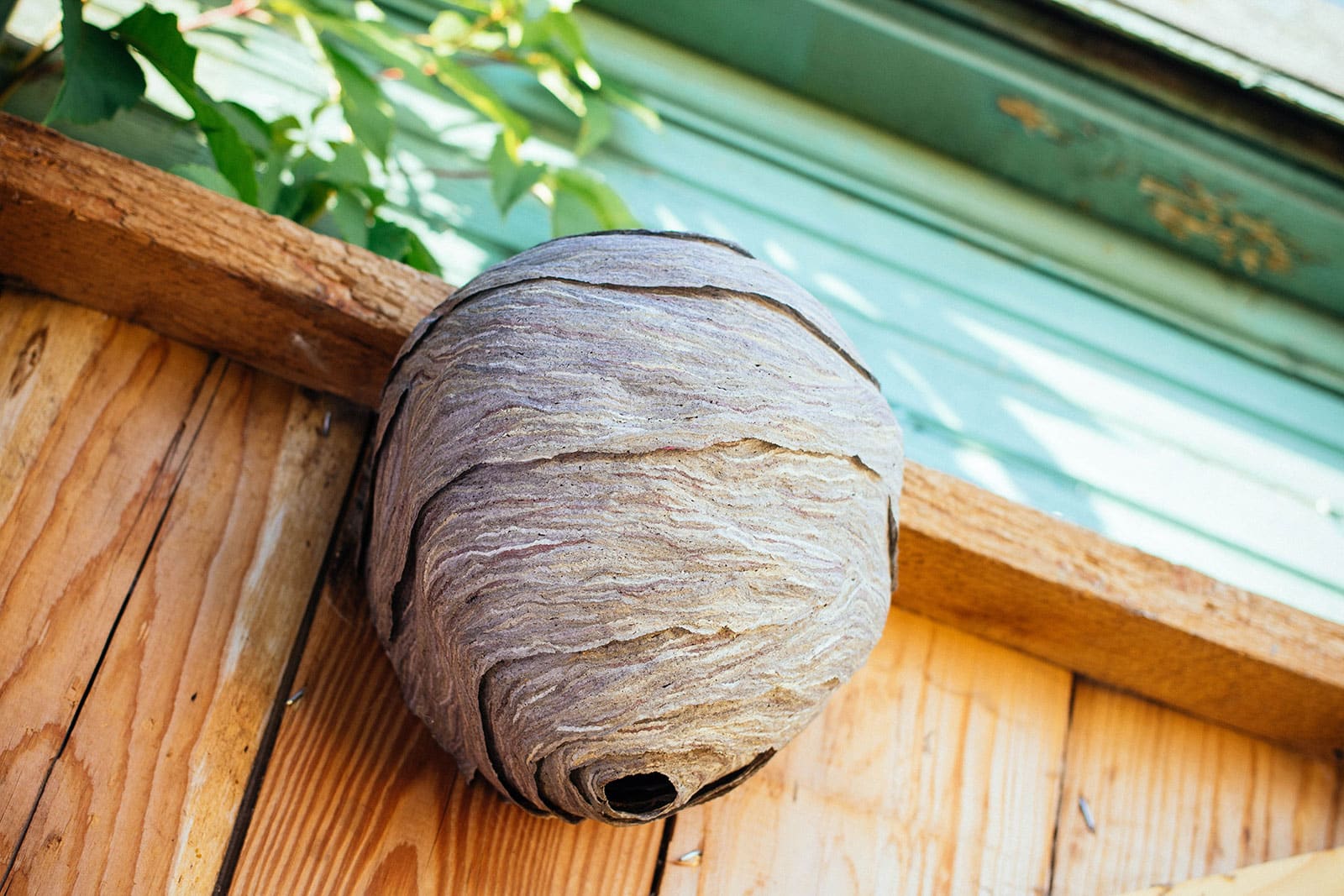
What not to do
Getting ready to remove an emerging wasp nest? As I said, you can get the smaller ones yourself, but there are some things to keep in mind.
Avoid doing the following:
- Pouring flammable liquid to “smoke out” underground wasp nests. Or just trying to burn wasp nests in general, really. Setting stuff on fire inadvertently is easier than you think, and any wasps that are not inside will come and attack you.
- Drowning a wasp nest. Again, any wasps that get out will not be amused, potentially leading to dangerous situations.
- Standing on a ladder to remove a nest. If the wasps do become cranky, you need to be able to get away easily without the risk of falling.
- The tennis racket method. If you’re thinking of taking a swing at the nest, just don’t. It’s a surefire way of getting stung all over.
Lastly: I hope this goes without saying, but if you know you’re allergic, just camp indoors while professionals take care of things.
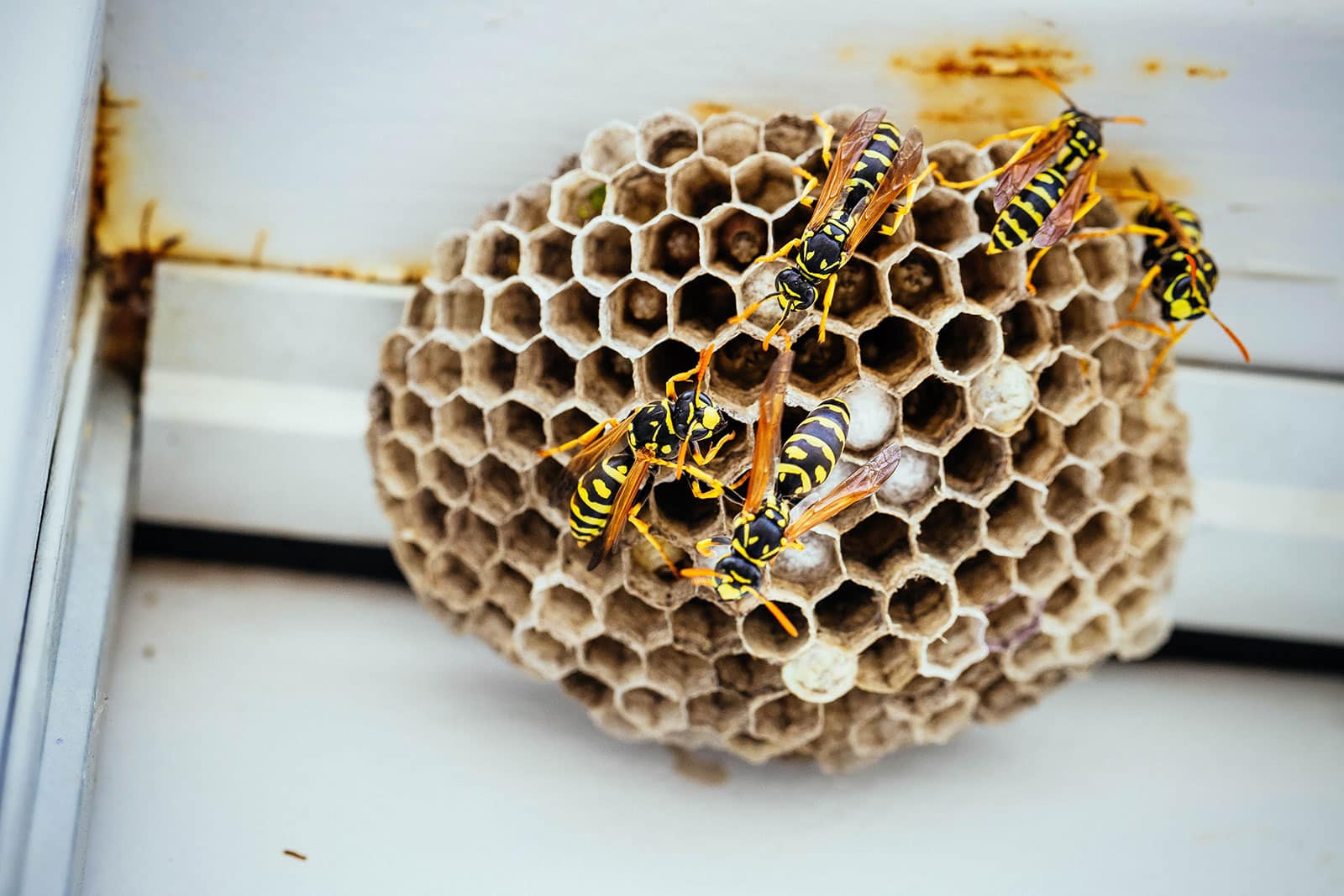
Common questions about getting rid of wasps
Do fake wasp nests work?
I’ve tried to find scientific studies about whether placing a fake wasp nest in your yard helps deter wasps, but unfortunately, there don’t seem to be any out there. However, it’s been reported that this is not a very effective method.
The idea is that wasps will avoid the area around another colony’s nest. It seems that using a decoy nest may discourage new colonies from settling nearby. However, it’s unlikely to deter existing populations, nor will it keep individual wasps from buzzin’ into your BBQ.
What eats wasps?
Funnily enough… other wasps. The bald-faced hornet (Dolichovespula maculata), as well as the European hornet (Vespa crabro) are two species that will gladly feast on a tasty yellowjacket.
The former is aggressive itself and not a very welcome visitor in the garden, but European hornets are actually quite polite. They keep to themselves, eat annoying bugs and don’t attack unless you disturb their nest.
As mentioned, I’ve had European hornet nests in my yard and the number of yellowjackets dropped significantly when they were present.
Other bugs that eat wasps include praying mantises, assassin flies (family Asilidae), dragonflies, and web-building spiders. Various birds, reptiles, and amphibians also consider them a snack.
All in all, maintaining a healthy ecosystem in your yard and welcoming all sorts of creatures is the best way to keep the wasp population under control!
Do fake wasp nests work?
I’ve tried to find scientific studies about whether placing a fake wasp nest in your yard helps deter wasps, but unfortunately, there don’t seem to be any out there. However, it’s been reported that this is not a very effective method.
The idea is that wasps will avoid the area around another colony’s nest. It seems that using a decoy nest may discourage new colonies from settling nearby. However, it’s unlikely to deter existing populations, nor will it keep individual wasps from buzzin’ into your BBQ.
What eats wasps?
Funnily enough… other wasps. The bald-faced hornet (Dolichovespula maculata), as well as the European hornet (Vespa crabro) are two species that will gladly feast on a tasty yellowjacket.
The former is aggressive itself and not a very welcome visitor in the garden, but European hornets are actually quite polite. They keep to themselves, eat annoying bugs and don’t attack unless you disturb their nest.
As mentioned, I’ve had European hornet nests in my yard and the number of yellowjackets dropped significantly when they were present.
Other bugs that eat wasps include praying mantises, assassin flies (family Asilidae), dragonflies, and web-building spiders. Various birds, reptiles, and amphibians also consider them a snack.
All in all, maintaining a healthy ecosystem in your yard and welcoming all sorts of creatures is the best way to keep the wasp population under control!
Do wasp traps work?
Wasp traps (DIY or store-bought) are contraptions that contain a wasp-attracting liquid like sugar or alcohol. When wasps enter to enjoy a snack, they fall in and drown. But is this an effective way to protect your picnics?
The main issue with wasp traps is that people tend to place them too close to themselves. It may seem logical to set up the trap near your lunch table so that any wasps attracted to your lemonade will be re-routed to it, but in reality, it just increases the overall number of wasps. Not ideal!
Hanging a wasp trap somewhere away from human activity may contribute to reducing the amount of wasps bothering you on those summer afternoons. However, keep in mind that it’s not an efficient way to get rid of the actual colonies at all.
Sources:
Papas, E., Tassoula, L., Lazarakis, D., & Harizanis, P. (2021). Color preference of social wasps to non-toxic traps. Journal of Apicultural Research, 1-6.
Zhang, Q. H., Schneidmiller, R. G., & Hoover, D. R. (2013). Essential oils and their compositions as spatial repellents for pestiferous social wasps. Pest management science, 69(4), 542-552.
View the Web Story on how to get rid of wasps.


